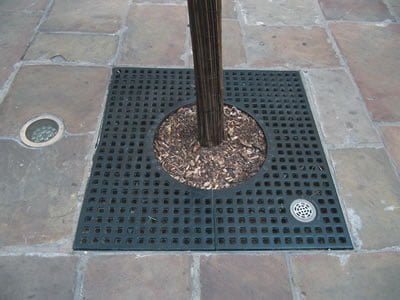Posted by Sophie Nichols on Thu, Dec 22, 2022 @ 5:25 AM
Tree Grates & Cities: WHAT TO KNOW

When you think of trees, images of the picturesque autumnal colours of an oak tree, or the breathtaking size of mature redwoods, come to mind. Trees give us as individuals a lot of joy and beauty, but in cityscapes, trees, if not managed currently, can be dangerous. Tree-related pedestrian injuries are much more common than you think and can result in costly settlements.
See our range of Tree Grates
Tree roots like meandering outside their designated rooting zone looking for water or nutrients, causing all sorts of damage ranging from pavement cracking to underground water pipe breakages.
Tree grates are one method to manage trees in cityscapes safely. If properly installed, tree grates essentially protect trees from pedestrians and pedestrians from trees. Tree grates are often categorized as a root management product, as they help to ensure tree roots stay in their intended rooting areas. Placed over the tree roots and around the tree trunk, grates have two primary purposes.
Related: Top Products for Tree Root Management.
Number one, to avoid soil compaction to allow for healthy tree growth, and number two, to ensure that the tree’s roots do not impact the surrounding pavements. With tree root protection underneath the grate, pedestrians are less likely to be tripped up by protruding roots. The tree grates also provide a more levelled surface, preventing pedestrian injury.
At Citygreen, we have developed a wide range of grates that will make cities greener and safer.
The Invisigrate™ is a pave-over grille, allowing the surrounding pavement to continue up to the tree trunk. This method eliminates any trip or slip hazards pedestrians often encounter and gives a clean style to the pavement.
This sub-surface grate can still incorporate all the essential irrigation inlets and checkpoints into the pavement. The benefit of this grate is that it allows designers to continue their choice of paving over the tree pit area for a more stylish and effortless finish.
The grate also has built-in tree irrigation/ventilation inlets and a removable inner section that allows tree growth.

How do tree-related pedestrian injuries impact urban areas?
Tree-related pedestrian injuries are not only a safety concern but also a significant financial burden for urban areas. When pedestrians trip over protruding roots or encounter uneven pavement caused by tree roots, it can lead to injuries and subsequent legal liabilities for the city. These injuries result in costly settlements, which can strain the city’s budget and resources.
Related: How to Stop Pavement Lift from Tree Roots
How do tree grates prevent soil compaction and ensure healthy tree growth?
Tree grates play a crucial role in preventing soil compaction by distributing the weight of foot traffic, vehicles, or other urban elements on to the grate or grille instead of the soil itself. This weight reduction helps maintain a healthier root system, allowing trees to access essential nutrients and water from the soil without fear of tree roots being damaged or causing harm to pedestrians. This, in turn, promotes healthier and more robust tree growth & safety.
What advantages do tree grates offer in terms of pedestrian safety and avoiding pavement damage?
Tree grates offer several advantages related to pedestrian safety and pavement protection. By covering the tree roots and creating a level surface, they prevent tripping hazards caused by protruding roots. Additionally, they safeguard pavements from cracking or upheaval due to root growth, ensuring a safer walking environment.
How do Citygreen’s range of tree grates contribute to greener and safer cities?
Citygreen offers a range of innovative tree grates, including the Invisigrate™. This unique solution contributes to greener and safer cities by allowing pavement to continue seamlessly around tree trunks. The Invisigrate™ eliminates trip and slip hazards, enhances pavement aesthetics, and maintains essential irrigation and ventilation for healthy tree growth.
What features and benefits does the Invisigrate™ provide, especially regarding its design and functionality?
The Invisigrate™ is designed for both aesthetics and functionality. It seamlessly integrates with pavement, eliminating tripping hazards. It also incorporates irrigation and ventilation inlets to support tree health. Its removable inner section encourages tree growth while providing a safe and stylish pavement finish.
Core Benefits
- Heavy duty recessed tree grille
- Allows specifiers to continue their choice of paving over the tree pit area
- Built-in tree irrigation/ventilation inlets
- Removable inner section allows for tree growth
- Robust galvanised construction
- Available in different sizes
- Available to comply with regular load specifications
Why is it important to strike a balance between protecting trees and ensuring pedestrian safety in urban environments?
Striking a balance between protecting trees and ensuring pedestrian safety is essential for maintaining the character and environmental feel of a city. Trees contribute to urban aesthetics and environmental benefits, but unmanaged tree growth can pose safety risks. Tree grates provide a harmonious solution by safeguarding both trees and pedestrians.
Installing tree grates is a straightforward and effective solution to enhance city safety and environmental sustainability. They offer a practical way to manage tree growth, ensuring pedestrian safety, and preserving the urban tree canopy. By adopting such solutions, cities can achieve their goals of being safer, greener, and more livable.
We can all agree that the protection of trees is vital for retaining a city’s character and environmental feel, but within cityscapes, trees need to be managed for pedestrian safety. Installing tree grates is one easy and effective way of achieving safer, greener, healthier cities.
See our range of tree guards here.
To learn more about our tree grates products, contact our friendly Citygreen Team.




